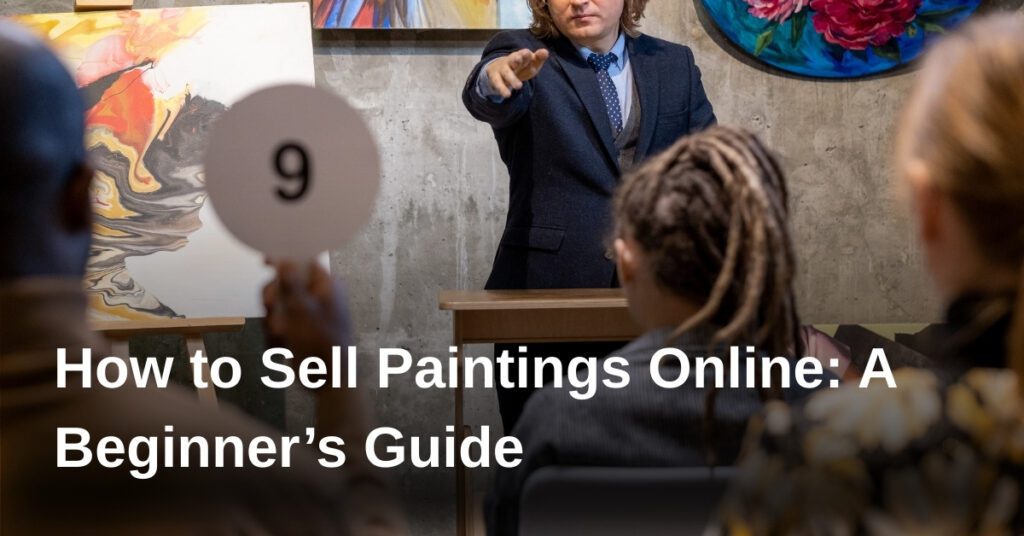
Taking your creative journey into the digital realm opens up many new opportunities for artists wanting to sell paintings to a wider audience. In today’s connected world, sharing your artwork online isn’t just about displaying talent—it’s also a way to reach collectors, enthusiasts, and casual buyers from all walks of life. However, making your first sale or building a thriving online presence can feel overwhelming if you’re new to these waters. That’s why understanding where to begin, which platforms to choose, and how to present your work effectively are crucial first steps. In this guide, you’ll find practical advice and insights to help you confidently start your journey to sell paintings online and turn your passion into a rewarding venture.
Main Points
When learning how to sell paintings online, it’s important to identify the right platforms, create high-quality images of your artwork, and write compelling descriptions. Setting fair prices ensures competitiveness while valuing your efforts. Understanding shipping and packaging processes guarantees a smooth experience for both you and your buyers. Building a personal brand and engaging with your audience on social media or dedicated art communities can significantly expand your reach. Lastly, staying informed about online trends and continually refining your listings will help you succeed as you develop your online art business.
Choosing the Right Online Platforms to Sell Your Paintings
Selecting effective platforms to Sell paintings can feel overwhelming because the digital art marketplace changes swiftly. While some sites appear popular, they might not align with your unique artistic style or target audience. Therefore, before you sell paintings online, consider the commission structure, ease of use, and the sense of community each platform offers. It’s wise to explore multiple options, as some artists discover success in unexpected places. For example, niche art platforms cater to specific genres, whereas broad marketplaces offer wider exposure yet stiffer competition.
- Platform popularity: evaluates how much traffic or exposure you might gain.
- Fees and commissions: affects potential profit from each sale.
- User-friendliness: determines how easily you can upload and manage your gallery.
Although trial and error may be inevitable, adapting your approach helps ensure your efforts to Sell paintings online yield the most promising results.
You Can Also Review These:
How To Sell Art Online: The Complete Guide (2025) – Shopify
Setting Up a Professional Artist Profile for Maximum Exposure
A compelling artist profile is essential if you aim to sell paintings online or in galleries. It should blend personal details and artistic vision in a way that feels genuine but professional. Begin with a high-quality photo and a concise, engaging bio. Many artists choose to share their journey, although the level of detail varies. Include your main medium, areas of expertise, and any notable exhibitions or awards. Potential buyers often look for unique perspectives, so highlight what sets your work apart. Add a Sell paintings section showcasing your best pieces, prices, and links to purchase or contact you. Remember, the design and tone should match your artistic style; consistency aids recognition. Additionally, updating your work regularly signals dedication. Some artists feature testimonials, while others rely on portfolio alone. Still, a clear call-to-action—such as how to Sell paintings or commission work—can make all the difference in connecting with an audience.
High-Quality Photography: Showcasing Your Artwork Online
To truly sell paintings online, the importance of high-quality photography cannot be overstated. Crisp, well-lit images help potential buyers connect with your work, enabling them to appreciate the texture, colour, and depth that might otherwise be missed. However, the perfect photo isn’t always easy to achieve—natural lighting and the right background can make a significant difference, yet sometimes minor imperfections remain. Because online shoppers can’t view your artwork in person, detailed close-ups and varied angles often help build trust and interest. Additionally, including in-situ shots—where paintings are placed within a styled environment—can make it easier for buyers to imagine your artwork in their own home. Nevertheless, while hiring a professional photographer is ideal for some, many artists achieve excellent results with just a smartphone and some experimentation. Therefore, investing time in photography elevates your online presence and enhances the chances to sell paintings and sell paintings successfully.
Writing Compelling Descriptions to Attract Art Buyers
Crafting an engaging description is essential to effectively Sell paintings online. Potential buyers often make decisions based not only on visuals but also the story that accompanies an artwork. Therefore, a captivating narrative can be a bridge between you and those who wish to invest in your art. Try to evoke emotion—explore what inspired the piece, its creative journey, and the mood it conveys. Highlight details such as the technique, color palette, or subtle elements that might not be obvious at first glance. Some descriptions may benefit from a touch of mystery, leaving viewers curious and encouraging further connection.
- Choose evocative words: Briefly describe the emotions or scenes you want buyers to imagine.
- Show context: Give insight into where the piece might belong, enhancing its appeal to Sell paintings effectively.
- Keep it concise: Clarity and brevity can often resonate more deeply than lengthy explanations.
When you skillfully integrate these elements, your chances to Sell paintings and spark genuine interest in your artwork may noticeably improve.
Pricing Strategies: How to Value Your Paintings for Online Sales
Setting the right price for your artwork when you sell paintings online can feel complex, partly because value in art is quite subjective. Start by considering your material costs, time invested, and level of experience. Research similar works on platforms where artists sell paintings to sense what buyers might expect to pay, but leave room for your unique style or technique. Sometimes, a slightly higher price can communicate exclusivity—especially if you offer limited editions. However, being too ambitious could discourage potential buyers. If you’re new to the scene, introductory prices may help you build reputation and earn reviews. As your audience and recognition grow, adjusting your rates becomes natural. Remember, your pricing might never feel perfect, but thoughtful evaluation and adaptability often pay off. To sell paintings successfully online, blend market awareness with your own sense of worth.
Marketing Your Paintings Through Social Media and Digital Channels
Effectively leveraging social media and digital platforms can greatly enhance your ability to sell paintings online. Today, reaching art lovers is increasingly about visibility and personal connection. Showcasing work on platforms like Instagram, Facebook, or Pinterest allows artists to build a sell paintings community around their style and narrative. Consistent posting tends to draw attention, but authenticity often matters more than frequency. Behind-the-scenes glimpses, time-lapse videos, or stories about the creative process make your feed more engaging.
Nevertheless, even with the perfect image and caption, algorithms sometimes limit reach. Therefore, interacting with followers through comments or live sessions becomes significant. Many artists experiment with ads or collaborations, although results can vary. Setting up a professional website or shop page is also recommended, as it creates a central hub for showcasing and transacting.
“Digital platforms open doors, but how you walk through them creates your audience.”
Monitoring what resonates, and adapting accordingly, keeps your sell paintings online approach flexible in this ever-changing digital landscape.
Understanding Online Payment and Shipping Options for Art Sales
Navigating online payment and shipping choices can feel complex when you aim to Sell paintings digitally. The variety of payment systems—from traditional cards to newer digital wallets—offers flexibility, yet sometimes confuses both sellers and buyers. Generally, most platforms support several payment methods, but fees and processing times can slightly vary. Therefore, understanding the terms helps prevent unwanted surprises.
- Credit/Debit cards: Convenient, yet may incur higher transaction fees.
- Digital wallets: Fast and gaining popularity, but not always accepted globally.
- Bank transfers: Reliable, though slower and often limited to local transactions.
Shipping options also require careful consideration, especially for those who wish to Sell paintings online internationally. Factors such as packaging, insurance, and tracking are vital. Although standard shipping might seem cost-effective, it might compromise safety. In my opinion, combining secure payment with tracked delivery increases buyer confidence and can enhance your reputation when you Sell paintings.
Protecting Your Artwork: Copyrights, Watermarks, and Legal Considerations
Understanding how to protect your artwork is crucial, especially when you Sell paintings online or in person. While Sell paintings internationally brings exciting opportunities, it can also raise complex issues around copyrights and intellectual property. You technically own the copyright in your work as soon as it’s created; however, registering your artwork may strengthen your legal position if disputes arise. Watermarks, though not foolproof, act as a deterrent against unauthorized use. Some artists prefer subtle marks, but others feel they detract from the piece’s aesthetic. Legal options exist if your images are used without permission, yet success can depend on jurisdiction and clear record-keeping. Although the law offers protection, it comes with its own ambiguities and occasional hurdles. Therefore, balancing visibility with security requires thoughtful consideration before you Sell paintings. Keeping detailed documentation may provide much-needed peace of mind.
Building Trust with Buyers: Reviews, Testimonials, and Customer Service
Establishing trust is crucial for those who wish to sell paintings online. Buyers often rely on authentic reviews, insightful testimonials, and responsive customer service to gauge reliability. A few positive reviews can encourage potential customers, while even one negative experience could discourage them, though sometimes context matters. Displaying genuine testimonials provides social proof, making it easier for hesitant buyers to take the leap and sell paintings or purchase them. Customer service, although sometimes overlooked, plays a significant role; quickly resolving queries or issues not only builds credibility but also enhances satisfaction. Some buyers may be unsure, but attentive support can often sway their decisions. Therefore, fostering transparent communication and responding to feedback promptly can have a noticeable impact. In my opinion, maintaining an open channel for customers to voice concerns, share feedback, or ask about your process helps to nurture lasting trust in the journey to sell paintings successfully.
Growing Your Art Business: Analytics, Feedback, and Continuous Improvement
Sustaining growth in your art business often calls for a dynamic approach, blending both creative intuition and real-world data. By closely monitoring Sell paintings statistics, you’ll spot which artworks resonate most with your audience—even if trends aren’t immediately obvious. Of course, seeking honest feedback from clients and peers is essential, although deciphering it may sometimes feel uncertain. This process can spark valuable insights that lead to fine-tuning your techniques, pricing strategies, or customer communication. Additionally, implementing modern analytics tools helps to identify subtle shifts in buyer interest. For instance, regular reviews of your Sell paintings performance might reveal that a specific medium or size attracts more attention. Harnessing this information allows you to adapt and evolve, ensuring your business remains relevant and appealing. Nevertheless, success rarely comes overnight; continuous small improvements, combined with a readiness to listen and change, will ultimately strengthen your Sell paintings efforts.
Conclusion
Starting your journey to sell paintings online may seem daunting at first, but with each step, it becomes more manageable and rewarding. Remember, building patience and persistence is just as important as creating your artwork because finding the right audience takes time. Trust your unique voice, present your work authentically, and embrace the learning curve. Although challenges will arise along the way, every effort you make is a step toward sharing your creativity with the world. Stay adaptable, keep refining your approach, and celebrate the milestones—no matter how small. In my opinion, your passion and dedication will resonate with art lovers searching for something just like what you offer.
Related Articles:
How to Sell Audiobooks Online: A Beginner’s Guide
